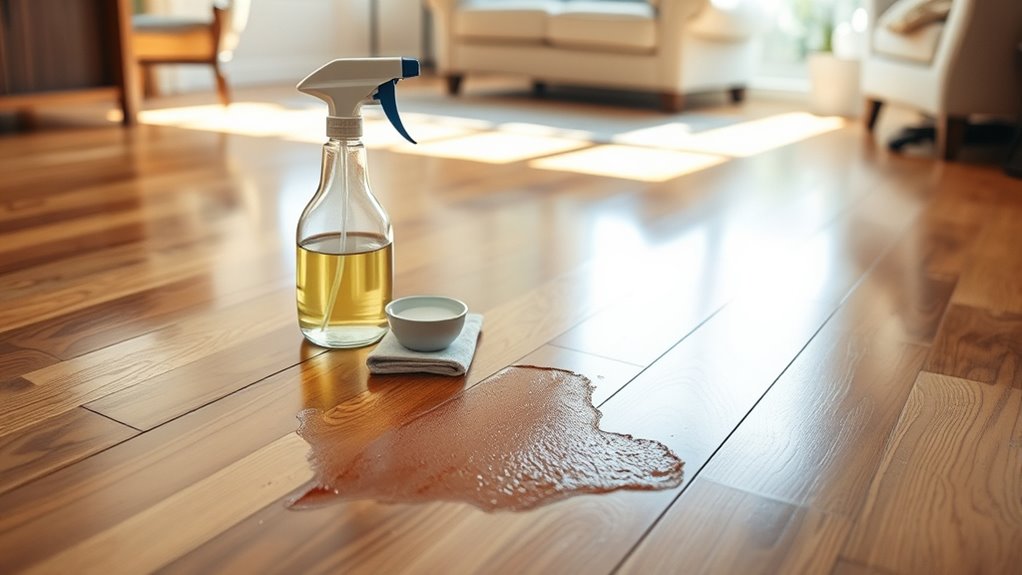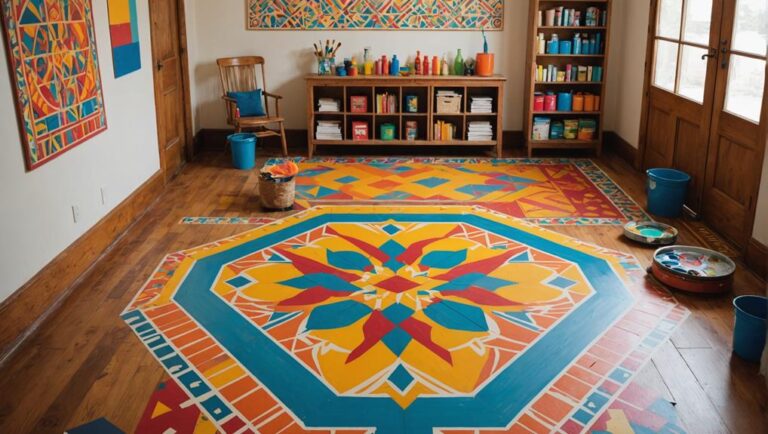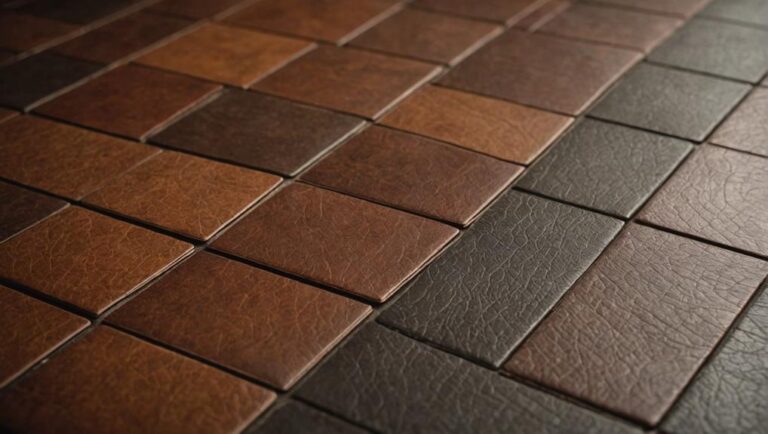First, locate and mark all urine spots using a UV light in a dim room. Blot the areas gently with microfiber cloths to absorb moisture without spreading it. Apply an enzymatic cleaner designed for pet urine, letting it sit for 10-15 minutes to neutralize odors, then wipe with a mild hardwood cleaner. Dry the floor thoroughly. To prevent repeats, establish designated bathroom spots for your dog and reinforce training regularly. Follow these steps carefully, and you’ll be on your way to restoring your hardwood floors effectively.
Identify the Affected Areas
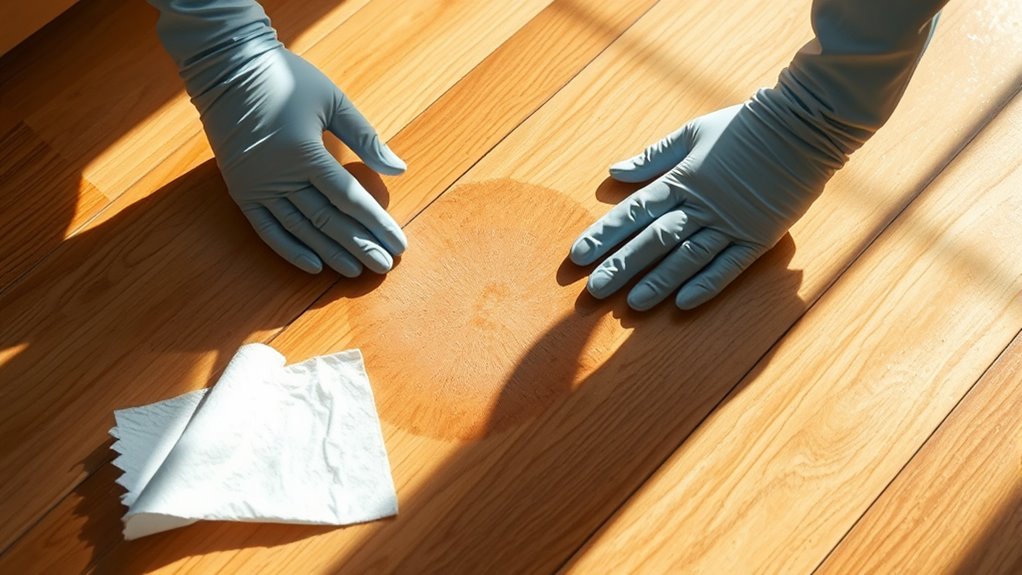
Before you begin cleaning, you’ll need to accurately identify all the spots where your dog has urinated. Effective urine detection is vital to guarantee no affected areas are missed, preventing lingering odors or permanent damage. Start by carefully inspecting the hardwood floor for visible discoloration or sticky patches—common signs of urine stains. To enhance stain identification, use a UV blacklight in a dimly lit room; urine fluoresces under UV light, revealing hidden spots invisible to the naked eye. Mark each affected area discreetly so you can focus your cleaning efforts precisely. This methodical approach to urine detection and stain identification not only saves time but also empowers you to restore your hardwood floors efficiently, maintaining your home’s freedom from stains and odors.
Gather Cleaning Supplies
Once you’ve identified all the affected areas, you’ll need to gather the right cleaning supplies to tackle the urine stains effectively. Choosing appropriate cleaning tools and solution options is crucial to restore your hardwood floor’s beauty without damage. Prepare to act decisively and confidently with these essentials:
- Soft microfiber cloths or paper towels for gentle cleaning
- Enzymatic cleaner specifically designed for pet urine to neutralize odors
- A mild hardwood floor cleaner to preserve the finish
- A spray bottle for precise application of solution options
Having these cleaning tools ready gives you the freedom to address the problem promptly and efficiently. This preparation guarantees you can restore your floors with minimal hassle, regaining control over your living space.
Blot Up Excess Urine
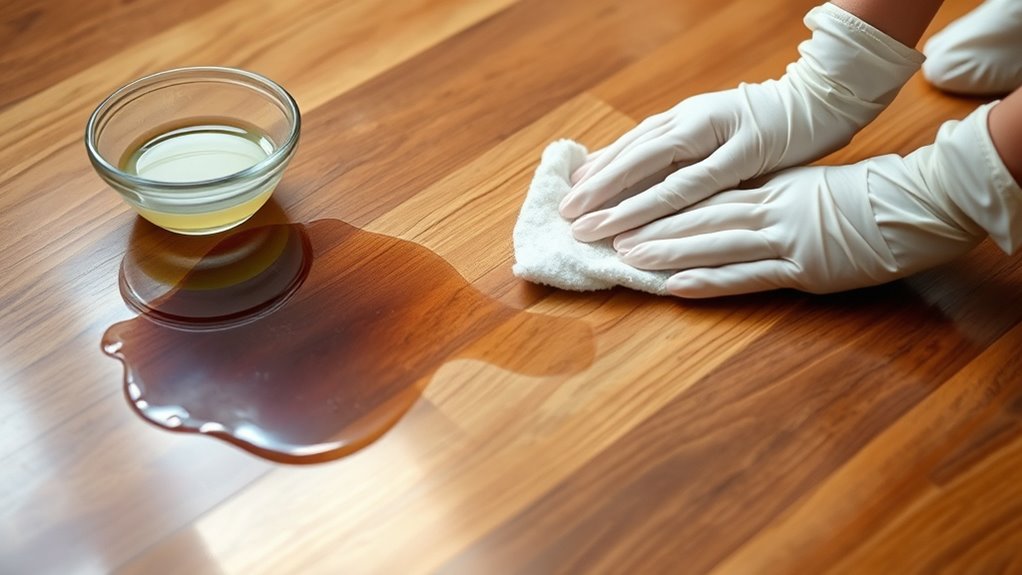
Start by gently blotting the urine with a soft microfiber cloth or paper towel to absorb as much liquid as possible. Avoid rubbing, as this can spread the urine and push it deeper into the wood. Use blotting techniques that involve pressing down firmly and lifting the absorbent material repeatedly to draw out moisture effectively. If the cloth becomes saturated, replace it with a fresh one to maintain absorption efficiency. Choosing highly absorbent materials like microfiber or thick paper towels will speed up the process and prevent lingering moisture. This methodical approach guarantees you remove the excess urine quickly, reducing the risk of stains or odor setting into your hardwood floors. Mastering these blotting techniques gives you control and freedom to protect your flooring with confidence.
Apply a Cleaning Solution
You’ll want to select a cleaner that’s safe for hardwood and effective against urine stains. Homemade solutions like a mix of vinegar and water can work well if prepared correctly. Apply the solution evenly, then let it sit for a few minutes to break down the stain before wiping it away.
Choosing the Right Cleaner
Selecting an appropriate cleaner is essential to effectively remove dog urine without damaging your hardwood floors. You want a solution that not only cleans but also preserves the wood’s natural beauty. Enzyme cleaners are a top choice—they break down urine molecules, eliminating odors and stains at the source. If you prefer something gentler, natural alternatives like vinegar or baking soda can work, but use them cautiously to avoid harming the finish.
When choosing your cleaner, consider these factors:
- Effectiveness in neutralizing odors and stains
- Safety for hardwood surfaces
- Environmental impact and toxicity
- Ease of use and availability
Mixing Homemade Solutions
A reliable homemade cleaning solution can be both effective and gentle on hardwood floors when dealing with dog urine. Start by mixing one cup of homemade vinegar with one cup of water in a spray bottle. Vinegar neutralizes odors and breaks down urine’s acidity without damaging the wood. Next, sprinkle baking soda generously over the affected area; this natural deodorizer absorbs moisture and lingering smells. After spraying the vinegar solution onto the baking soda, you’ll notice fizzing—that’s the reaction working to lift stains and odors. Avoid using harsh chemicals that can strip your floor’s finish. By combining homemade vinegar and baking soda thoughtfully, you maintain your hardwood’s integrity while tackling dog urine. This method gives you control and freedom to clean safely and effectively at home.
Applying and Letting Sit
Once you’ve prepared your cleaning solution, apply it evenly over the urine-stained area. Using careful applying techniques guarantees the solution penetrates the wood without oversaturating it. Spread the liquid gently with a soft cloth or sponge, covering all affected spots thoroughly. After application, focus on letting solution sit undisturbed for at least 10-15 minutes. This waiting period allows the solution to break down urine compounds effectively, freeing you from lingering odors and stains.
- Feel empowered as you reclaim your floor’s natural beauty.
- Experience relief knowing the odor will vanish.
- Enjoy the freedom of a clean, fresh home environment.
- Trust your methodical approach to protect your hardwood.
Rinse and Dry the Floor
Begin by thoroughly rinsing the affected area with clean, lukewarm water to remove any remaining cleaning solution and urine residue. Use a damp cloth or mop to guarantee all liquids are lifted away. Next, apply drying techniques promptly to avoid moisture damage to your hardwood. Air drying combined with gentle towel blotting works best for hardwood maintenance, preserving the floor’s finish and structure.
| Step | Purpose |
|---|---|
| Rinse with lukewarm water | Eliminate residual cleaning agents |
| Blot dry with towels | Absorb moisture quickly |
| Air dry completely | Prevent warping and stains |
Following these steps guarantees your floor dries efficiently, maintaining its natural beauty and freeing you from lingering odors or damage.
Prevent Future Accidents

To prevent future accidents, you’ll need to focus on consistent potty training to reinforce good habits. Using repellent sprays can help discourage your dog from marking unwanted spots. Additionally, establishing designated bathroom areas makes it easier for your pet to know where to go.
Consistent Potty Training
Although removing dog urine stains is crucial, consistent potty training is the key to preventing future accidents on your hardwood floors. By establishing positive reinforcement and consistent schedules, you create a reliable routine your dog can follow, reducing the chances of indoor mishaps. Here’s how to maintain effective potty training:
- Reward your dog immediately after successful outdoor bathroom breaks to reinforce good behavior.
- Set fixed times for walks and bathroom breaks, aligning with your dog’s natural rhythms.
- Monitor your dog closely for signs they need to go, intervening promptly.
- Be patient and persistent; setbacks are normal but consistency will lead to freedom from accidents.
This methodical approach guarantees your floors stay clean and you gain peace of mind, enabling you and your dog to enjoy a harmonious living space.
Use Repellent Sprays
A reliable way to discourage your dog from urinating on hardwood floors is by using repellent sprays specifically designed for pets. These dog deterrents work by emitting scents that your dog finds unpleasant, effectively signaling that the area isn’t suitable for bathroom breaks. When applying, guarantee the floor is clean and dry to maximize the spray’s effectiveness. Repellent sprays often contain natural scent blockers that neutralize urine odors, preventing your dog from being attracted back to the same spot. Use the spray consistently, especially after cleaning any accidents, to reinforce the message. Remember, combining these sprays with consistent training enhances your chances of success, giving you freedom from repeated messes and preserving your hardwood’s beauty.
Establish Designated Areas
When you establish designated areas for your dog to relieve itself, you greatly reduce the chances of accidents on your hardwood floors. Setting clear urine boundaries helps your dog understand where it’s appropriate to go, preserving your flooring and your peace of mind. Choose designated spots that are easy to clean and accessible for your dog. Consistently guiding your dog to these spots reinforces good habits and protects your home’s integrity.
Consider these steps to create effective urine boundaries:
- Select low-traffic, durable floor areas
- Use training pads or outdoor zones as reference points
- Reward your dog immediately after successful use
- Maintain a consistent schedule to build routine

